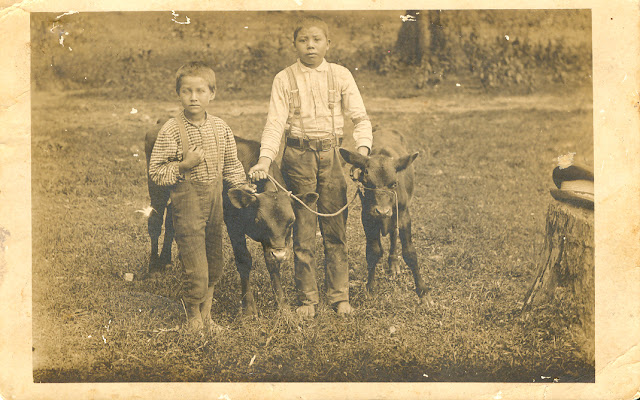Every archival collection usually contains photographs of mystery people. Who were these individuals? How do we identify them? It becomes difficult after 20 to 30 years. It's nearly impossible after 100. Yet sometimes clues occur in an unusual fashion. Here's a brief display of the processes an archivist often goes through.
The Thomas John Blumer Collection contains nearly 3,000 photographs and 5,700 slides, mostly related to the Catawba Indian Nation. Many of these photographs are unidentified although Catawba elders have helped add many names.
The photographic postcard below has always been a mystery:
First let's review what is known about this photograph. It is part of the Blumer Catawba Photograph Collection and is one of a series of 17 images captioned:
1. Folder 188: Fred
Sanders Album. Photograph 1 is a
professional shot taken in Germany (Oct. 1945), 2 -8, 10 by TJB, 11-17 found in
the Fred Sanders correspondence.
2. This is actually a "real photo postcard." The reverse of this image is a postcard that could be mailed. Real photo postcards were published on Kodak Professional AZO Paper and can be approximately dated by the "stamp box" on the back. The pattern of four triangles pointed upwards dates this image to somewhere between 1904-1918. Photographic publishers often kept stocks of paper until they were used up however, so it's possible this image was made several years later using older paper.
Therefore we have an image probably associated with the family of Fred Sanders and it dates somewhere approximately between 1904-1918 and possibly later. For the last decade that's been all that I've known. Occasionally I'd pull the image and resign myself to never knowing.
Yet today, while processing an oral history for the Native American South Carolina Digital Archive I found the following dialogue from a 1984 Oral History Interview with Catawba Sallie Wade, conducted by Dr. Blumer. They are discussing George Brown, the son of two well known Catawbas, John Brown and Rachel Wysie Brown.
TB: What happened to his eyes? How did he get blind?
SW: He got blind when he was little. I don’t know how, he
just went blind I reckon. Because he was a small kid when he went blind. I
remember that. His eyes got sore and they thought that—he had a little horse
that played with all the time. They thought maybe he got—
TB: Something from that?
SW: Something from that horse, but I don’t know. But he went
blind in both eyes at the same time I know that. He got sore eyes when he went blind and never did
get better.
TB: Yeah, I spoke to him and he said that John Brown [George’s
father] took him everywhere.
SW: Yeah.
TB: To every doctor he could find.
I've always wondered if the boy on the left in the photograph was blind. His eyes are closed and often the eyes of blind individuals remain closed or open infrequently due to whatever caused the blindness. There is also the fact that George Brown was the uncle of Fred Sanders and perhaps the photograph found it's way into his album from Fred's mother, Arzada, the sister of George.
George Brown was born in 1914 so if this was taken about 1918 he would be about three or four. The boy seems to be several years older though. However, John Brown was a large "big-boned" man and his sons were large men. And the postcard could have been made several years after 1918 which would work.
The narrative did go on to say that George Brown received special schooling, lived in Columbia and got married in 1952.
Conclusions:
The boy may simply have closed his eyes when the photo was taken like many of us do today. Everything you've just read may be an absolute flight of archival whimsy. There is no concrete evidence.
I will however make a judgement call and change the listing for this photograph to read "Boy on left is possibly George Brown" which doesn't really say anything at all. I'll also include a copy of what you've just read so that fifty years from now patrons will know why the archivist made this call. There is even a remote chance that somewhere there is an individual who knows the answer and will reach out.
In the meantime though, it's actually a really amazing photograph.

1 comment:
Hello,
Both Dr. Blumer and I think that your theory is spot on. We also think that it is an amazing photograph and that you and the NASC are doing a great service.
Robert Smith
Post a Comment